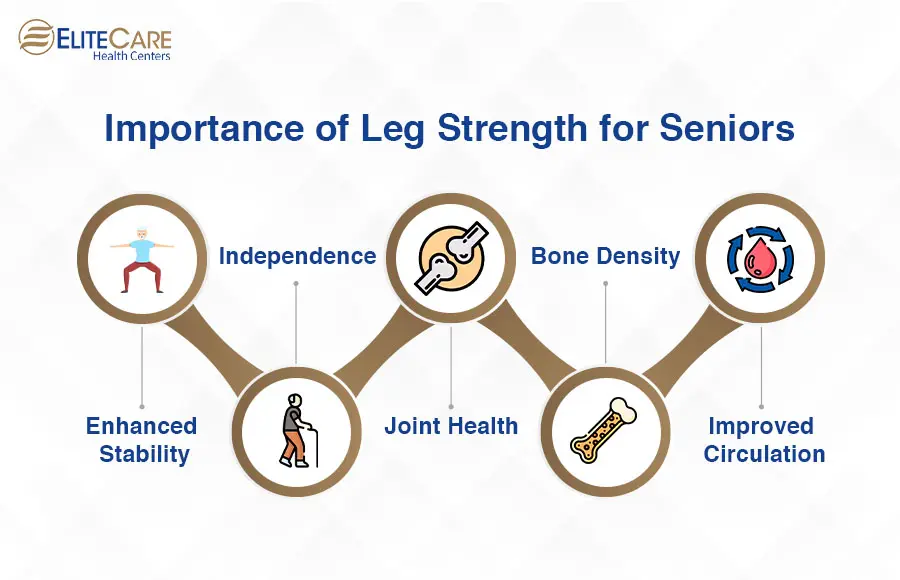As we age, maintaining leg strength becomes increasingly important. Strong legs are essential for staying active, independent, and safe. They provide stability, improve balance, and lower the risk of falls—critical factors for seniors looking to maintain their mobility. Unfortunately, as we grow older, muscle mass naturally declines, and joints may become stiffer. Fortunately, regular leg exercises can combat these effects, helping to enhance overall leg strength and promote better health.
Why Leg Strength Matters for Seniors
Before diving into specific exercises, it’s important to understand why leg strength is so crucial for older adults. The benefits extend far beyond just muscle tone:

- Improved Stability and Balance: Strong legs play a significant role in preventing falls, one of the most serious risks for seniors. Better leg strength directly enhances your balance and coordination, making everyday activities safer.
- Increased Independence: From climbing stairs to standing up from a chair, leg strength is essential for performing many daily tasks without assistance. Strong legs help seniors maintain their autonomy and avoid becoming overly reliant on others.
- Joint Health: Regular exercise can help reduce the stiffness and discomfort that often come with aging joints. Moving the legs strengthens muscles around the joints, improving flexibility and mobility.
- Bone Density: Weight-bearing exercises, like those that target the legs, can help maintain or even improve bone density, reducing the risk of osteoporosis and fractures.
- Enhanced Circulation: Strong legs improve blood flow, which benefits cardiovascular health and lowers the risk of conditions like deep vein thrombosis (DVT).
By incorporating leg-strengthening exercises into your routine, seniors can enjoy these benefits and more.
The 10 Best Leg-Strengthening Exercises for Seniors
These 10 exercises are designed to help seniors increase leg strength, improve mobility, and reduce the risk of injury. Each one is safe and can be performed at home, making them ideal for seniors who want to stay active without the need for a gym membership or expensive equipment.
1. Chair Squats
Chair squats are an excellent way to target the quadriceps, hamstrings, and glutes. They mimic the motion of sitting and standing, which is a functional movement many seniors do daily.
How to do it:
- Stand in front of a firm chair with feet hip-width apart.
- Slowly lower your body toward the chair as if you were going to sit down.
- Keep your knees aligned with your toes and ensure your weight is on your heels.
- Once you reach the chair, push through your heels to return to standing.
Start with using the chair for support, and over time, reduce the assistance as your strength increases.
2. Leg Raises
This simple seated exercise strengthens the quadriceps and hip flexors while improving flexibility.
How to do it:
- Sit upright in a firm chair with feet flat on the floor.
- Extend one leg straight out in front of you, keeping it parallel to the floor.
- Hold the position for a few seconds, then lower the leg slowly.
- Repeat on the other leg.
Perform each lift with slow, controlled movements to avoid jerking and maintain balance.
3. Calf Raises
Calf raises are great for building strength in the lower legs, particularly the calves, which help with balance and walking.
How to do it:
- Stand with your feet hip-width apart, and use a countertop or wall for support if needed.
- Raise your heels off the ground, standing on your toes.
- Hold the position for a few seconds before slowly lowering your heels back down.
- Repeat for 10-15 reps.
Calf raises help strengthen the muscles necessary for walking and standing.
4. Step-Ups
Step-ups target the quadriceps, hamstrings, and glutes, enhancing leg strength and coordination.
How to do it:
- Find a sturdy step or platform.
- Step one foot onto the platform, ensuring the entire foot is on the surface.
- Push through the heel to lift your body onto the step.
- Step down and repeat with the opposite leg.
Start with a lower step and gradually increase the height as you get stronger.
5. Seated Marching
This seated exercise works the hip flexors and quadriceps and is great for seniors with limited mobility.
How to do it:
- Sit with your back straight and feet flat on the floor.
- Lift one knee towards your chest, hold for a few seconds, then lower it back down.
- Repeat with the opposite leg.
- Perform at a controlled pace to maintain stability.
This exercise is a great way to engage the muscles without putting too much strain on the joints.
6. Wall Sit
A wall sit is an isometric exercise that strengthens the quads, hamstrings, and glutes. It also helps improve endurance.
How to do it:
- Stand with your back against a wall.
- Lower your body until your knees form a 90-degree angle, as though sitting in an invisible chair.
- Hold the position as long as comfortable, then rise back up.
Start with shorter holds and gradually work up to longer durations as your strength improves.
7. Resistance Band Leg Press
This seated exercise utilizes resistance bands to work the quadriceps, hamstrings, and glutes, adding intensity to leg presses.
How to do it:
- Sit in a chair and loop a resistance band around one foot, anchoring it to a stationary object.
- Extend your leg out against the band’s resistance, then slowly return it to the starting position.
- Repeat on the other leg.
Adjust the resistance as needed to match your strength level.
8. Lunges
Lunges engage the quadriceps, hamstrings, and glutes, and are excellent for improving balance and coordination.
How to do it:
- Stand with your feet hip-width apart.
- Take a step forward with one leg, lowering your body until both knees are at 90-degree angles.
- Push off the front foot to return to the starting position.
- Repeat with the opposite leg.
Perform lunges with controlled movements to avoid straining the knees.
9. Toe Taps
Toe taps are a simple seated exercise that targets the quadriceps and hamstrings.
How to do it:
- Sit upright with feet flat on the floor.
- Lift one foot and gently tap it on the floor in front of you.
- Return the foot to its starting position and repeat with the opposite foot.
This low-impact exercise is easy to perform while watching TV or relaxing at home.
10. Heel-to-Toe Walk
The heel-to-toe walk is great for improving balance and coordination.
How to do it:
- Stand with your feet in a straight line, with one heel directly in front of the other toe.
- Step forward with one foot, placing the heel directly in front of the toe of the other foot.
- Continue walking in a straight line, maintaining the heel-to-toe rhythm.
For added support, perform this exercise near a wall or counter.
Safety First
Before starting any new exercise routine, especially for seniors, it’s important to prioritize safety:
- Always consult with a healthcare professional before beginning a new exercise program, particularly if you have pre-existing health conditions.
- Begin with low-intensity exercises and gradually increase difficulty as your strength builds.
- Focus on proper form to minimize the risk of injury and maximize the effectiveness of each exercise.
- If you experience any pain or discomfort, stop immediately and consult a healthcare provider.
- Stay hydrated by drinking water before, during, and after exercise.
- Incorporate a gentle warm-up and cool-down to prevent stiffness.
By regularly incorporating these leg-strengthening exercises, seniors can significantly improve their strength, balance, and overall mobility, ensuring a healthier and more independent lifestyle. With consistency and gradual progression, it’s never too late to begin enhancing leg strength and enjoying the many benefits of an active lifestyle.



